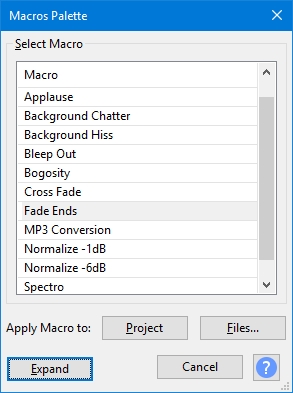Using Macros to Automate Frequent Tasks
A Macro is a sequence of pre-configured commands (mainly effects) in a set order that can be applied automatically to projects or audio files.
What are the main uses for Macros?
Macros in Audacity can be used for:
Batch processing: Apply one or more effects to multiple audio files and export the processed audio into a new file.
To use this select the Apply Macro to: Files... button in the Macros Palette or the Manage Macros dialog.
For more detail on batch processing please see this page.
Effects automation: where the selected audio in the track or tracks in the current project is subjected to the same prescribed sequence of effects, and optionally, a file exported from the entire audio.
Effect presets: where selected, commonly used, effects are stored with your preferred settings for quick re-use.
How to access Macros
You can manage and apply Macros using the Tools Menu:
Tools > Macros... to manage Macros: to create, edit and test them
Tools > Apply Macro > Palette... for a toolbox of Macros
Tools > Apply Macro > named Macro to apply one named Macro
There are some examples of Macros and tips on using them.
Use Tools > Macros... if you need to create a new Macro or to edit an existing Macro.

Macros Palette dialog
Use the Shrink button to show a reduced Macros Palette dialog which lists the existing Macros.
This dialog is also available directly via Tools > Apply Macro > Palette...

Apply Macro to
Both the Manage Macros dialog and the Macro Palette dialog have Apply Macro to buttons:
Project applies the selected Macro to the current project.
Files... applies the selected Macro to selected external audio files that are in a single directory.
For more details see the Macros Palette page.
Macro Command Parameters
Commands that call Effects, Generators, Analyzers or Tools, use the same familiar graphical interface (GUI) as appears when they are used from the normal top level menus.
Many of the other commands provide a simple GUI comprised of checkboxes and text entry boxes. Typical examples can be seen in the Scriptables I and Scriptables II menus.
Please see Manage Macros for more details.
Sharing a Macro
You can export a Macro as a TXT file using the Export button in Manage Macros and send it to another user, or copy it to another computer for use there
You can import another user's Macro, or a copied macro of your own, into your Macros folder by using the Import button in Manage Macros.
Where Macros are stored
Each Macro is automatically saved as a separate text file with TXT extension in the Macros folder in Audacity's folder for application data:
Windows: Users\<username>\AppData\Roaming\audacity\Macros
Mac: ~/Library/Application Support/audacity/Macros
Linux: ~/.audacity-data/Macros
Macros Examples
See the Macros Examples page for examples of using Macros
Last updated
Was this helpful?